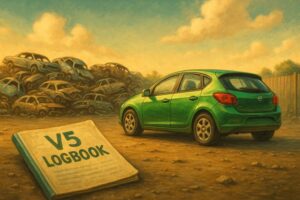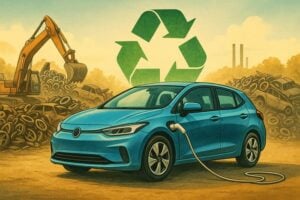Think about how many cars are on the road today. Millions, right? Now imagine what happens when they reach the end of their lives. Without car recycling, we’d be drowning in old, rusting vehicles. But car recycling hasn’t always been the sophisticated process it is today. It has a long history, shaped by necessity, innovation, and a growing awareness of environmental impact. Let’s take a journey through time to see how it all began.
The Early Days – Scrap Metal and Simple Solutions
Before cars, recycling wasn’t really about the environment. It was about getting the most out of materials. Metal was valuable, and people reused whatever they could. When the first cars appeared in the late 19th and early 20th centuries, they were luxury items. Only the wealthy owned them, and when they broke down, they were often repaired rather than scrapped.
By the 1920s, more people could afford cars, and the demand for new vehicles grew. This meant old ones started piling up. But these early cars were mostly made of steel, which was easy to melt down and repurpose. Scrap metal dealers saw an opportunity, and the first car recycling efforts began—though it wasn’t called that back then. People simply sold their broken cars to scrapyards, where they were stripped for useful parts and materials.
The Impact of War – A Turning Point
When World War II broke out, recycling became a national effort. Governments urged people to collect metal for weapons, vehicles, and machinery. Old cars were a perfect source. Many were scrapped to support the war effort, with steel being melted down and repurposed for tanks, planes, and other military needs. Recycling wasn’t just about waste management—it was about survival.
After the war, the automotive industry boomed. Car production soared, and with it, so did car waste. Scrap yards became more organised, and businesses began specialising in dismantling vehicles properly. It was still a fairly simple process—strip out anything useful, crush the rest, and melt it down—but it set the foundation for the industry we know today.
The Rise of Auto Recycling Businesses
By the 1960s, car ownership had exploded. People were buying new models more often, and old cars were being abandoned in fields, backyards, and even rivers. It was a growing problem, and something had to change.
Enter the first dedicated auto recycling businesses. These companies didn’t just scrap cars for metal—they saw value in parts too. Instead of crushing everything, they removed working components and sold them as spare parts. This was a game-changer. People could now buy second-hand parts to fix their cars instead of always opting for expensive new ones. This shift helped reduce waste and made car ownership more affordable.
The Environmental Awakening of the 1970s and 1980s
The 1970s brought a wave of environmental awareness. People started realising that dumping cars in landfills or leaving them to rust wasn’t sustainable. Governments took notice, and laws were introduced to regulate car disposal.
Recycling became more structured. Instead of focusing just on metal and parts, businesses started looking at how to handle other materials like rubber, glass, and plastic. The industry had to evolve. This meant better processes for dismantling vehicles, safer ways to dispose of harmful substances like engine oil and coolant, and a stronger push to reuse and recycle as much as possible.
The 1990s – Car Recycling Gets Serious
By the 1990s, car recycling was no longer just about scrapping metal. It became a full-blown industry with strict regulations. Governments around the world introduced rules to ensure old cars were disposed of responsibly.
One major change was how cars were handled at the end of their lives. Instead of being abandoned or crushed immediately, they went through a structured scrapping process. First, hazardous materials like battery acid and fuel were removed. Then, useful parts were salvaged. Finally, the remaining shell was shredded, with metals separated and sent for recycling.
During this time, manufacturers also started designing cars with recycling in mind. More vehicles were built with materials that could be reused, and dismantling became easier. It was a shift towards sustainability that laid the groundwork for modern recycling efforts.
The 21st Century – Smarter, Greener and More Efficient
Fast forward to today, and car recycling is more advanced than ever. Around 95% of a car’s materials can now be reused or recycled. That’s a huge improvement from the early days when most of a car ended up in a landfill.
Technology has played a big role in this progress. Modern shredding machines can separate different materials with incredible accuracy. Recycling facilities use high-tech sorting systems to ensure everything from aluminium to plastics is recovered efficiently. And with growing concerns about climate change, the push for greener scrapping processes has never been stronger.
Another big change is electric vehicles (EVs). While they don’t have the same scrap metal value as traditional cars, their batteries present a new challenge. Recycling EV batteries is complex, but researchers are developing new methods to extract valuable materials like lithium and cobalt. As electric cars become more common, this will be a key area of focus for the recycling industry.
Why Car Recycling Matters More Than Ever
Car recycling isn’t just about getting rid of old vehicles. It helps save natural resources, cuts down on waste, and reduces pollution. Every time metal is recycled instead of mined, it saves energy. Every time a car part is reused, it means one less new part needs to be made. It all adds up.
Looking ahead, car recycling will keep evolving. With new materials, changing regulations, and advances in technology, the industry will need to adapt. But one thing is certain—it will remain a crucial part of managing the millions of vehicles that reach the end of their lives every year.
So next time you see an old car heading for the scrapyard, remember—it’s not just junk. It’s the start of something new.
If you’d like to scrap your vehicle safely and responsibly by a reputable company, look no further. Get a quote below!






